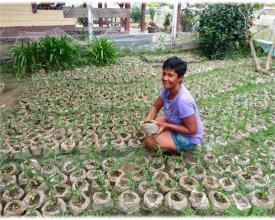
Aumentar la resiliencia costera y las oportunidades de desarrollo social: Proyecto de restauración de los manglares de Guyana (GMRP)

Reconociendo el impacto potencial del cambio climático en su zona costera baja, Guyana inició un programa para restaurar sus manglares costeros. Esta solución responde al cambio climático y mitiga sus efectos mediante la protección, restauración y uso racional de los ecosistemas de manglares de Guyana a través de procesos que mantienen su función protectora, sus valores y su biodiversidad, al tiempo que satisfacen las necesidades de desarrollo socioeconómico y protección medioambiental en las zonas estuarinas y costeras.
Contexto
Défis à relever
Ubicación
Procesar
Resumen del proceso
Bloques de construcción
Gestión comunitaria de los manglares
Factores facilitadores
Lección aprendida
Restauración ecológica de los manglares
Factores facilitadores
Lección aprendida
Recursos
Impactos
Las actividades del proyecto se tradujeron en la producción de más de 500.000 plantones de mangle y la restauración de 142 ha de manglar costero. Los esfuerzos de restauración del manglar se combinaron con la protección y gestión de 30 kilómetros de franjas existentes para evitar que siguieran agotándose debido a actividades antropogénicas. El GMRP trabajó con las comunidades para garantizar su participación en todos los niveles de la ejecución del proyecto. Las mujeres están al frente de esta iniciativa, con más del 80% de la participación comunitaria. Las mujeres son empoderadas como líderes medioambientales y fueron formadas para ser líderes en sus comunidades, difundiendo información sobre la importancia de los manglares y la necesidad de proteger y restaurar los manglares costeros. Los programas de formación se centraron en las diversas iniciativas puestas en marcha por el proyecto, como la educación, el turismo, el espíritu empresarial y la gestión de los manglares. Más de 50 mujeres recibieron formación para cultivar plántulas de mangle en viveros comunitarios. Estas 250.000 plántulas se vendieron para su plantación en la costa y reportaron a las mujeres participantes un total de 115.000 dólares. Gracias a la formación en apicultura y turismo, las mujeres formaron la Sociedad Cooperativa de Productores de la Reserva de Manglares, que ahora imparte formación a mujeres pobres de la costa interesadas en la apicultura. Además de proporcionar ingresos gracias a la producción de miel, esta actividad contribuye a fomentar el crecimiento y la protección de los manglares.
Beneficiarios
Objetivos de Desarrollo Sostenible
Historia









